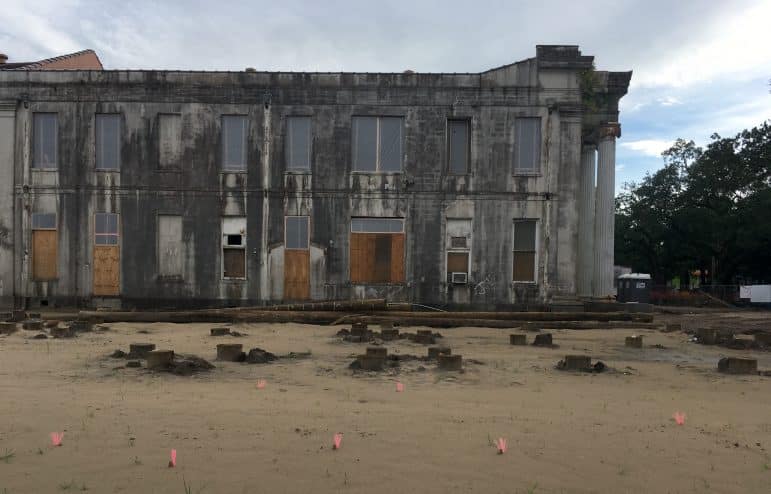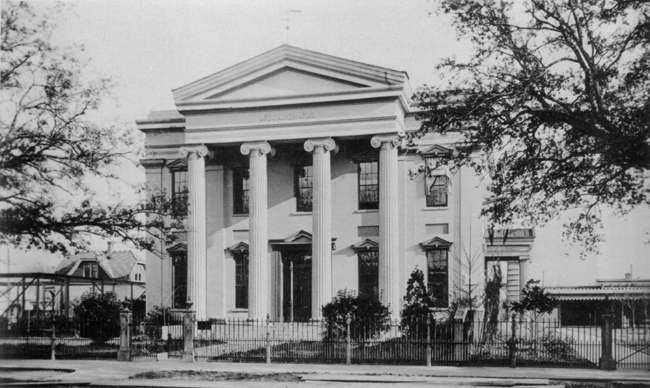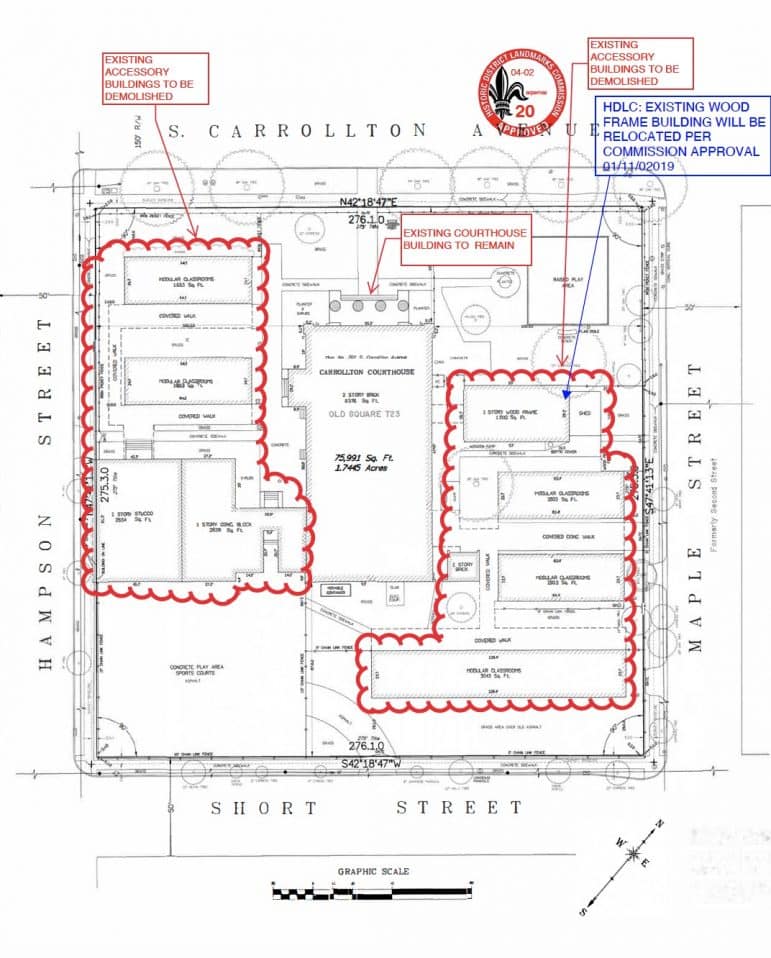
Uptown Messenger
The 19th century school house next to the Carrollton Courthouse, photographed on July 7, was demolished in May.
The demolition of a former classroom building next to the Carrollton Courthouse cost the developers the highest possible fine levied by the Historic District Landmark Commission, a fine the commissioners bemoaned as not high enough.
The wood-frame building, deemed historic by the HDLC, was torn down in May to make room for the an addition to the Greek Revival landmark building, which is being converted to an assisted living and memory-care residence.
The 1,400-square-foot school building dates to the 19th century, the HDLC has determined. The Carrollton Courthouse only briefly operated as a courthouse for the town of Carrollton when it was the seat of Jefferson Parish, according to a history of the building by the HDLC. It was converted to a school, then McDonogh 23, after the area was annexed to New Orleans in 1874.

This photo of the Carrollton Courthouse building was published in an 1895 book, “Art Work of New Orleans.” The small schoolhouse building can be seen on the left.
In January 2019, the HDLC, while approving the demolition of other auxiliary buildings on the site, required that the historic wooden building be relocated instead of torn down. It was to be moved to a new home at the Music Box Village in the Bywater neighborhood.
The developers dismantled it instead, salvaging the front door and the double-hung windows and items such as the blackboards, shelving and clock, to be donated to the nonprofit that operates the Bywater sculpture park and performance space. Other materials, such as the siding and asphalt-shingle roof, were not retained.
At the virtual hearing on Wednesday (July 7), the developers requested that the HDLC retain the demolition of the wooden building on the landmark site.
“We were proceeding in earnest,” said Patrick Schindler of Felicity Property Co., part of the development group. “There was no darkness-of-night effort. We were very transparent in what we did.”
Schindler noted that the developers went through a three-year permitting process with multiple community meetings.
In addition, a description of dismantling the building is among the notes in a 293-page packet of building plans submitted for the HDLC’s Certificate of Appropriateness. That packet received the HDLC’s red stamp of approval in September 2020.
Eleanor Burke, the HDLC’s deputy director, responded to the statement that HDLC staff had signed off on the demolition.
“We have never discussed with the developer or the architect a proposal to dismantle the structure and add salvage parts to a new construction at the new site,” Burke said. “So we were concerned that a note to that effect would be insinuated into a drawing set without any discussion — because that’s not something that we could have even approved at the staff level.” Only the commission, not staff members, can approve a demolition.
Schindler said the developers were encouraged, not required, to relocate the building. Referring to the demolition note in plan packet, he said: “That note was not an effort to bait and switch anything. That note was part of our plan just like any other detail in there.”
“Yeah, but if it was that detailed,” said Commissioner Jason R. King, “how is one line in there, in 300 pages, going to be determined?”
Schindler said they had no economic reason to dismantle rather than move the building. He also told the commissioners the city had awarded the developers a demolition permit for the Carrollton site and a new construction permit for the Music Box Village site.
The demolition permit on file, however, was for the other buildings on the site, not the one-story schoolhouse.
Meghan Murphy, a plan reviewer for Safety & Permits, said the permit for Music Box Village was approved as a relocation, not as new construction. The Music Box Village operators told the city the historic structure was to be moved from Carrollton Avenue and placed on new piers.
“It was considered new construction only because that building had not existed on that site,” Murphy said.

via Historic District Landmark Commission
Demolition plan for 719 S. Carrollton Ave.
Lee Bressler, the commissioner for the Carrollton historic district, moved to levy the maximum fine of $10,000 and to deny retention of the demolition, which would send the issue to the City Council for further review. “There’s too much uncertainty for such a high-profile project,” he said.
Bressler, who spent four years on the property as a Benjamin Franklin High School student, also said the $10,000 fee was too low for a large commercial project.
That motion failed, with seven voting against and four in favor. Those who voted against said they did not agree with denying retention when the demolition was already a done deal. “I don’t think anything can be accomplished by denying the retention,” said Commissioner Calvin Alexander. “The building is gone.”
The commissioners then decided by a 10-1 vote, with King voting against, to fine the developers for demolishing the building without a permit but to retain the demolition.
At the same time, they discussed how the fines can be made a more significant deterrent.
“I think that we all agree that we’re kind of boxed in here,” said Commissioner Annie Cambria. “Honestly, $10,000 in this instance is barely a drop in the bucket. It is just a cost of doing business — people are going to be willing to pay that fine.”
The fines, however, are set by the State Legislature. Chairman Jesse LeBlanc II said he would establish a subcommittee to determine a new fine structure and to work with state officials on putting new fines in place.
“I think all the commissioners recognize that the state needs to revisit these fines,” he said.
Appreciate UM’s coverage of real estate/historical preservation news.
Whoa…..
Somebody got paid off…
What a tragedy…
This is ALMOST unbelievable..may everyone involved go to jail and meet a bad end.
This REALLY is shocking even for the current era in tragic New Orleans.
All the the beautiful trees,too, AND they EVEN CHOPPED UP THE HISTORIC OAKS ON CARROLLTON.
Oh yes….somebody MUST go to jail.
What was the historical significance of the demolished building? Why was this structure considered historically significant while the other 8-9 demolished buildings were not?